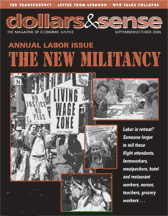
Dear Dr. Dollar:
Back in first-year economics we learned that there is a tradeoff between unemployment and inflation, so you can't really have both low inflation and low unemployment at the same time. Do economists still consider that to be true?
—Edith Bross, Cambridge, Mass.
This article is from the September/October 2006 issue of Dollars & Sense: The Magazine of Economic Justice and is available at http://www.dollarsandsense.org
Subscribe Now
at a 30% discount.

This article is from the September/October 2006 issue of Dollars & Sense magazine.
The trade-off between inflation and unemployment was first reported by A. W. Phillips in 1958—and so has been christened the Phillips curve. The simple intuition behind this trade-off is that as unemployment falls, workers are empowered to push for higher wages. Firms try to pass these higher wage costs on to consumers, resulting in higher prices and an inflationary buildup in the economy. The trade-off suggested by the Phillips curve implies that policymakers can target low inflation rates or low unemployment, but not both. During the 1960s, monetarists emphasized price stability (low inflation), while Keynesians more often emphasized job creation.
The experience of so-called stagflation in the 1970s, with simultaneously high rates of both inflation and unemployment, began to discredit the idea of a stable trade-off between the two. In place of the Phillips curve, many economists began to posit a ”natural rate of unemployment.“ If unemployment were to fall below this ”natural“ rate, however slightly, inflation would begin to accelerate. Under the ”natural rate of unem-ployment“ theory (also called the Non-Accelerating Inflation Rate of Unemployment, or NAIRU), instead of choosing between higher unemployment and higher inflation, policymakers were told to focus on ensuring that the economy remained at its ”natural“ rate: the challenge was to accurately estimate its level and to steer the economy toward growth rates that maintain price stability, no matter what the corresponding level of unemployment.
The NAIRU has been extremely difficult to pin down in practice. Not only are estimates of it notoriously imprecise, the rate itself evidently changes over time. In the United States, estimates of the NAIRU rose from about 4.4% in the 1960s, to 6.2% in the 1970s, and further to 7.2% in the 1980s. This trend reversed itself in the 1990s, as officially reported unemployment fell. In the latter half of the 1990s, U.S. inflation remained nearly dormant at around 3%, while unemployment fell to around 4.6%. In the later Clinton years many economists warned that if unemployment was brought any lower, inflationary pressures might spin out of control. But growth in these years did not spill over into accelerating inflation. The United States, apparently, had achieved the Goldilocks state—everything just right!
What sustained this combination of low inflation and low unemployment? Explanations abound: a productivity boom, the high rates of incarceration of those who would otherwise fall within the ranks of the unemployed, the openness of the U.S. economy to world trade and competition, among others.
The full story, however, has to do with class conflict and the relatively weak position of workers in the 1990s. Both the breakdown of the Phillips curve in the 1970s and the recent ”disappearance“ of the natural rate of unemployment are in essence a reflection of institutional and political changes that affect the bargaining strength of working people—in other words, their ability to organize effective unions and establish a decent living wage.
Following the Reagan offensive against trade unions, workers’ power fell dramatically. Consequently, unionization rates and the real value of the minimum wage each fell precipitously between the late 1970s and the 1990s. The period of stagflation, in contrast, had been one of labor militancy and rising wages. (Although ”stagflation“ has a negative ring, by many measures nonsupervisory workers—i.e., the vast majority of the U.S. labor force—fared better in the economy of the early- to mid-1970s than they do today, even after the long 1990s economic expansion.) Labor’s weaker position in the 1990s meant that despite low unemployment, workers were not able to win higher wages that would have spurred inflation.
The long period of stable prices and low interest rates in the United States now seems to be coming to a close. The cost of the Iraq War and rising oil prices, among other factors, have fueled expectations of a resurgence of inflation. At the same time, the near jobless recovery from the last recession might suggest that the ”natural rate“ of unemployment is on the rise again—and that we are witnessing yet another twist in the strange history of the Phillips curve!
With inflation rising (albeit slowly, and still relatively mild at around 4.2%), some business sectors will no doubt begin clamoring for tighter monetary policies that sacrifice job-creation and wage growth by slowing the economy growth. But these fears of inflation are probably misplaced. A moderate rate of inflation is conducive to the growth of real investment, and in the context of a decades-long squeeze on workers’ wage share, there is room to expand employment without setting off a wage-price spiral. What workers need is not greater fiscal and monetary austerity, but rather a revival of a Keynesian program of ”employment targeting“ that would sustain full employment and empower workers to push for higher wages. It’s not likely, however, that the owners of capital and their political allies would sit idly by were such a program to be enacted.
Did you find this article useful? Please consider supporting our work by donating or subscribing.
